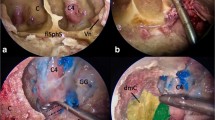Abstract
Purpose
The aim of this study was to investigate the neurovascular structures and their relevant anatomy with the endonasal endoscopic transpterygoid approach on fresh human cadavers. In addition, the relationship between the vidian nerve, ICA and surrounding structures were investigated
Methods
This study was carried out at an otolaryngology department of a tertiary medical center between June 2014 and June 2015. Ten fresh human cadavers were included in this study. Pterygopalatine fossa was explored via an endoscopic endonasal transpterygoid approach. Same surgical dissection procedures were performed on all cadavers: maxillary antrostomy, anterior and posterior ethmoidectomy, sphenoidotomy, transpterygoid pterygopalatine fossa and vidian canal dissection.
Results
Mean distance between the anterior nasal spine and ethmoidal crest was 60.35 ± 1.31 mm (range 59–64 mm). Mean distance between the sphenopalatine foramen and superior border of choana was 18.30 ± 1.38 mm (range 17–22 mm). Mean distance between the vidian canal and sphenopalatine foramen was 6.30 ± 0.47 mm (range 5.5–7 mm). Mean distance between the vidian canal and anterior nasal spine was 64.6 ± 1.71 mm (range 62–67 mm). Foramen rotundum was located superior lateral to the vidian canal in all specimens. Mean distance between foramen rotundum and vidian canal was 9.45 ± 0.60 mm (range 8.5–10.5 mm). Course of the greater palatine nerve was always medial to the descending palatine artery. The mean length of the vidian nerve from the petrous ICA to the point the nerve exits the vidian canal (vidian canal length) was 17.90 ± 1.59 mm (range 16–20 mm).
Conclusions
The distances between the vidian canal and surrounding neurovascular structures would help the skull base surgeon in this narrow and complex area.







Similar content being viewed by others
References
Fortes FSG, Sennes LU, Carrau RL et al (2008) Endoscopic anatomy of the pterygopalatine fossa and the transpterygoid approach: development of a surgical instruction model. Laryngoscope 118:44–49
DelGaudio JM (2003) Endoscopic transnasal approach to the pterygopalatine fossa. Arch Otolaryngol Head Neck Surg 129:441–446
Bolger WE (2005) Endoscopic transpterygoid approach to the lateral recess: surgical approach and clinical experience. Otolaryngol Head Neck Surg 133:20–26
Har-El G (2005) Combined endoscopic transmaxillary-transnasal approach to the pterygoid region, lateral sphenoid sinus, and retrobulbar orbit. Ann Otol Rhin Laryngol 114:439–442
Zanation AM, Snyderman CH, Carrau RL et al (2009) Endoscopic endonasal surgery for petrous apex lesions. Laryngoscope 119:19–25
Kassam AB, Prevedello DM, Carrau RL et al (2009) The front door to Meckel’s cave: an anteromedial corridor via expanded endoscopic endonasal approach-technical considerations and clinical series. Neurosurgery 64(3 Suppl):71–82 (discussion 82–83)
Vescan AD, Snyderman CH, Carrau RL et al (2007) Vidian canal: analysis and relationship to the internal carotid artery. Laryngoscope 117:1338–1342
Alfieri A, Jho HD, Schettino R, Tschabitscher M (2003) Endoscopic endonasal approach to the pterygopalatine fossa: anatomic study. Neurosurgery 52(2):374–378
Kassam AB, Gardner P, Snyderman C et al (2005) Expanded endonasal approach: fully endoscopic, completely transnasal approach to the midline third of the clivus, petrous bone middle cranial fossa and infratemporal fossa. Neurosurg Focus 19:1–10
Shires CB, Boughter JD, Sebelik ME (2011) Sphenopalatine artery ligation: acadaver anatomic study. Otolaryngol Head Neck Surg 145:494–497
Midilli R, Orhan M, Akyildiz S et al (2009) Anatomic variations of sphenopalatineartery and minimally invasive surgical cauterization procedure. Am J Rhinol Allergy 23:38–41
Maeda S, Aizawa Y, Kumaki K et al (2012) Variations in the course of the maxillary artery in Japanese adults. Anat Sci Int 87:187–194
Pandolfo I, Gaeta M, Blandino A et al (1987) The radiology of the pterygoid canal: normal and pathologic findings. Am J Neuroradiol 8:479–483
Kim HS, Kim DI, Chung IH (1996) High resolution CT of the pterygopalatine fossa and its communications. Neuroradiology 38(Suppl 1):S120–S126
Acknowledgements
Special thanks to Merve Evren fort the medical illustrations.
Author information
Authors and Affiliations
Corresponding author
Ethics declarations
Informed consent
Not required because the study was conducted on cadavers.
Ethical approval
All procedures performed in studies involving human participants were in accordance with the ethical standards of the institutional and/or national research committee and with the 1964 Helsinki declaration and its later amendments or comparable ethical standards.
Conflict of interest
The authors declare that they have no conflict of interest.
Rights and permissions
About this article
Cite this article
Karci, B., Midilli, R., Erdogan, U. et al. Endoscopic endonasal approach to the vidian nerve and its relation to the surrounding structures: an anatomic cadaver study. Eur Arch Otorhinolaryngol 275, 2473–2479 (2018). https://doi.org/10.1007/s00405-018-5085-2
Received:
Accepted:
Published:
Issue Date:
DOI: https://doi.org/10.1007/s00405-018-5085-2




